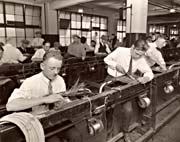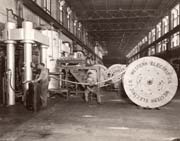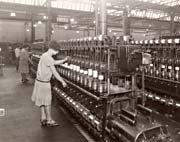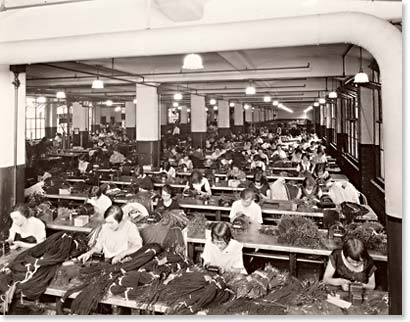
The Interview Process
I think interviewing is a good idea. It helps some people get a lot of things off their chest.Western Electric employee, in Comments and Reactions on Interviewing Program, ca. 1930
 Factory Cabling Department, ca. 1925Assisting Mayo was his research assistant, Fritz Roethlisberger. Unassuming, bookish, and disciplined, Roethlisberger had studied philosophy at Harvard. He worked as a psychological counselor for Harvard students and became known as an expert listener. Roethlisberger, who found himself “spellbound by Mayo’s…creative imagination and clinical insights,” would himself become one of Harvard Business School’s beloved and highly sought after professors.7
Factory Cabling Department, ca. 1925Assisting Mayo was his research assistant, Fritz Roethlisberger. Unassuming, bookish, and disciplined, Roethlisberger had studied philosophy at Harvard. He worked as a psychological counselor for Harvard students and became known as an expert listener. Roethlisberger, who found himself “spellbound by Mayo’s…creative imagination and clinical insights,” would himself become one of Harvard Business School’s beloved and highly sought after professors.7
 Long Stroke Lead Sheathing Press, ca. 1925Under Mayo and Roethlisberger’s direction, the Hawthorne experiments began to incorporate extensive interviewing. The researchers hoped to glean details (such as home life or relationship with a spouse or parent) that might play a role in employees’ attitudes towards work and interactions with supervisors. From 1928 to 1930 Mayo and Roethlisberger oversaw the process of conducting more than 21,000 interviews and worked closely training researchers in interviewing practices.
Long Stroke Lead Sheathing Press, ca. 1925Under Mayo and Roethlisberger’s direction, the Hawthorne experiments began to incorporate extensive interviewing. The researchers hoped to glean details (such as home life or relationship with a spouse or parent) that might play a role in employees’ attitudes towards work and interactions with supervisors. From 1928 to 1930 Mayo and Roethlisberger oversaw the process of conducting more than 21,000 interviews and worked closely training researchers in interviewing practices.
 Magnetic Wire Insulating Department, ca. 1925Mayo and Roethlisberger’s methodology shifted when they discovered that, rather than answering directed questions, employees expressed themselves more candidly if encouraged to speak openly in what was known as nondirected interviewing. “It became clear that if a channel for free expression were to be provided, the interview must be a listening rather than a questioning process,” a research study report noted. “The interview is now defined as a conversation in which the employee is encouraged to express himself freely upon any topic of his own choosing.”8
Magnetic Wire Insulating Department, ca. 1925Mayo and Roethlisberger’s methodology shifted when they discovered that, rather than answering directed questions, employees expressed themselves more candidly if encouraged to speak openly in what was known as nondirected interviewing. “It became clear that if a channel for free expression were to be provided, the interview must be a listening rather than a questioning process,” a research study report noted. “The interview is now defined as a conversation in which the employee is encouraged to express himself freely upon any topic of his own choosing.”8
 Cord Finishing Department, ca. 1925
Cord Finishing Department, ca. 1925
Interviews, which averaged around 30 minutes, grew to 90 minutes or even two hours in length in a process meant to provide an emotional release. The resulting records, hundreds and hundreds of pages in which employees disclose personal details of their day to day lives, offer an astonishingly intimate portrait of the American industrial worker in the years leading to and following the Depression. In a pre-computer age, thousands of comments were sorted into employees’ attitudes about general working conditions, specific jobs, or supervisors and among these categories into favorable and unfavorable comments used to support interpretations of the data. Both workers’ and supervisors’ comments would aid in the development of personnel policies and supervisory training, including the subsequent implementation of a routine counseling program for employees.
In his autobiography The Elusive Phenomena, Roethlisberger wrote of grappling with objective, hard data versus subjective, soft data. “I felt very strongly,” he noted, "that in the gooey soft data there existed uniformities about human behavior that had to be coaxed out by…the method of clinical observation and interviewing which I was advocating for the administrator to use.9 Roethlisberger discovered that what employees found most deeply rewarding were close associations with one another, “informal relationships of interconnectedness,” as he called them. “Whenever and where it was possible,” he wrote, “[employees] generated them like crazy. In many cases they found them so satisfying that they often did all sorts of nonlogical things…in order to belong.10 In Mayo’s broad view, the industrial revolution had shattered strong ties to the workplace and community experienced by workers in the skilled trades of the 19th century. The social cohesion holding democracy together, he wrote, was predicated on these collective relationships, and employees’ belief in a sense of common purpose and value of their work.
- 7
- Paul Lawrence quoted in Andrea Gabor, The Capitalist Philosophers: The Geniuses of Modern Businessâ€"Their Lives, Times, and Ideas. New York: Random House, 1999, p. 92. ←
- 8
- "Hawthorne Studies Research Report," 1932. Western Electric Company, Hawthorne Studies Collection, Baker Library, Harvard Business School. ←
- 9
- Fritz J. Roethlisberger, The Elusive Phenomena: An Autobiographical Account of My Work in the Field of Organizational Behavior at the Harvard Business School. Boston: Division of Research, Graduate School of Business Administration, Harvard University, 1977, p. 238. ←
- 10
- Fritz J. Roethlisberger, The Elusive Phenomena: An Autobiographical Account of My Work in the Field of Organizational Behavior at the Harvard Business School. Boston: Division of Research, Graduate School of Business Administration, Harvard University, 1977, p. 165. ←
- Baker Library | Historical Collections | Site Credits | Digital Accessibility
- Contact Email: histcollref@hbs.edu
